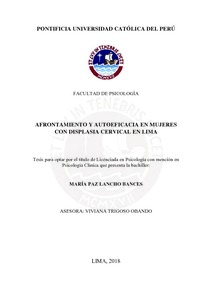| dc.contributor.advisor | Trigoso Obando, Viviana María | es_ES |
| dc.contributor.author | Lancho Bances, María Paz | es_ES |
| dc.date.accessioned | 2018-05-04T14:39:23Z | es_ES |
| dc.date.available | 2018-05-04T14:39:23Z | es_ES |
| dc.date.created | 2018 | es_ES |
| dc.date.issued | 2018-05-04 | es_ES |
| dc.identifier.uri | http://hdl.handle.net/20.500.12404/11996 | |
| dc.description.abstract | La presente investigación tuvo como objetivo describir la relación entre las estrategias de
afrontamiento y la autoeficacia percibida en un grupo de 50 mujeres de 19 a 60 años
(M=37.16, DE=10.98) diagnosticadas con displasia cervical que reciben tratamiento en
un instituto especializado de Lima. Para ello, se utilizó el Cuestionario de estimación de
afrontamiento (COPE) de Carver, Schreier y Weintraub (1989) y la escala de autoeficacia
de Baessler y Schwarzer (1996). Se encontró una relación positiva entre la autoeficacia y
las estrategias de afrontamiento activo, planificación, aceptación, reinterpretación
positiva y crecimiento y uso del humor. Además, se encontraron diferencias significativas
en función a la edad de las participantes en la autoeficacia percibida, y las estrategias de
afrontamiento activo, reinterpretación positiva y crecimiento y acudir a la religión. | es_ES |
| dc.description.abstract | The aim of this study was to describe the relationship between coping strategies and self
efficacy in a group of 50 women between the ages of 19 and 60 (M=37.16, DE=10.98)
diagnosed with cervical dysplasia and currently in treatment. Thus, the spanish version
of the General self efficacy Scale (GSE) of Baessler and Schwarzer (1996), and the Cope
inventory of Carver, Schreier & Weintraub (1989) were used. Positive and significant
correlations were found between self efficacy and the following coping strategies: active
coping, planning, acceptance, positive reinterpretation and humor. Also, according to the
age of the participants, there were found significant differences in self–efficacy and
strategies such as active coping, positive reinterpretation and religion. | es_ES |
| dc.language.iso | spa | es_ES |
| dc.publisher | Pontificia Universidad Católica del Perú | es_ES |
| dc.rights | Atribución-NoComercial-SinDerivadas 2.5 Perú | * |
| dc.rights | info:eu-repo/semantics/openAccess | es_ES |
| dc.rights.uri | http://creativecommons.org/licenses/by-nc-nd/2.5/pe/ | * |
| dc.subject | Adaptación (Psicología) | es_ES |
| dc.subject | Autoeficacia | es_ES |
| dc.subject | Mujeres--Enfermedades | es_ES |
| dc.title | Afrontamiento y autoeficacia en mujeres con displasia cervical en Lima | es_ES |
| dc.type | info:eu-repo/semantics/bachelorThesis | es_ES |
| thesis.degree.name | Licenciado en Psicología con mención en Psicología Clínica | es_ES |
| thesis.degree.level | Título Profesional | es_ES |
| thesis.degree.grantor | Pontificia Universidad Católica del Perú. Facultad de Psicología | es_ES |
| thesis.degree.discipline | Psicología con mención en Psicología Clínica | es_ES |
| renati.discipline | 313026 | es_ES |
| renati.level | https://purl.org/pe-repo/renati/level#tituloProfesional | es_ES |
| renati.type | http://purl.org/pe-repo/renati/type#tesis | es_ES |
| dc.publisher.country | PE | es_ES |
| dc.subject.ocde | https://purl.org/pe-repo/ocde/ford#5.01.00 | es_ES |






